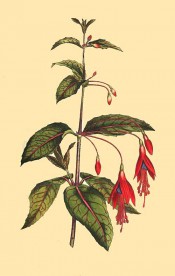The Fuchsias of Camden Park
The first fuchsia introduced to English gardens in 1788 was a variety of Fuchsia magellanica Lam., then known as Fuchsia coccinea. This new plant soon attracted the attention of florists and, stimulated by the regular introduction of new species and varieties from South America, selection and hybridisation soon saw a rapidly increasing number of named varieties available through the nurseries. The first record of a fuchsia at Camden Park is Fuchsia conica, which arrived on board the ‘Sovereign’ in February 1831. By 1857 fifty-eight species, cultivars and hybrids had been recorded as growing in the gardens.
The development of the garden fuchsia, and its attributes as a florists’ flower is well described in the Floricultural Cabinet, the author anonymous but probably the conductor Edward Henderson.
‘The Fuchsia has been placed, in the language of flowers, as the emblem of taste, for with its richly coloured blossoms there is a peculiar harmony and beauty in the unassuming appearance of the flowers, which hang with so much gracefulness from amongst the elegant-shaped foliage of the plant. The length of the stamens also add greatly to the beauty of these pendent blossoms, having the appearance of so many gems suspended from a small roll, in many instances, of the richest violet-coloured ribbon, over which the beautiful calyx hangs like a half-expanded parachute, allowing only a glimpse of the rich purple, violet, or other handsome corollas to be seen between the openings, the whole being headed by an emerald-coloured receptacle for the seed. The more modern taste as to what constitutes a perfect blossom has decided that the sepals should reflex so that the tips of the segments curve inwards, thus fully exposing the corolla to view. The calyx buds, before they are expanded, have the appearance of ripe barberries, and in some kinds the veins of the leaves are tinged with a fine crimson colour, which contributes to the beauty of the plant.
The first Fuchsia which was introduced into England was the F. coccinea, a native of Chili. It was unknown to the Old World until the year 1788, when a plant was presented by Captain Firth to the Royal Gardens at Kew, from whence it was soon afterwards distributed as a stove plant. Mr. Lee, nurseryman, of Hammersmith, was the first who had plants for sale, which, from their great beauty, brought a high price, from ten to twenty pounds per plant being given. Since that period a vast number of species and improved varieties have been introduced into our gardens, and none more singularly neat and pretty than those with a white corolla, that have recently been raised; two of the very best we have figured in our present number, and others having double white corollas, also striped ones, we intend to give in a short time.
Fifteen years ago the charming Fuchsia venus-victrix was raised [which see], and its flowers having a clear white tube and sepals, with a violet-blue corolla, were universally admired. Attention was soon directed to obtain similarly coloured flowers of a larger size; the first was our Queen Victoria, of large size, white tube and sepals, with scarlet corolla (figured in vol. x of this Magazine) [see Harrison’s “Queen Victoria”], and subsequently many other white ones have been raised, having corollas of various shades from crimson to deep purple. The two varieties figured in our present number, having richly coloured tubes and sepals, with pure white corollas, are just the reverse in arrangement of colour to the previous section we have above noticed, rendering them a most valuable and highly interesting addition to this lovely blooming family, and supply us with sources for hybridizing and raising still greater beauties of this section. Many years ago we had a Fuchsia thymifolia, the flowers were small, changeable in colour from dark mulberry to pale pink, and in occasional instances it had pure white blossoms. We do not know what kinds of Fuchsias were impregnated by the raiser to obtain the new varieties having white corollas, as well as others we have referred to, but have been told that a variety with flowers wholly white was raised, and that between it and a variety named Bank’s Glory [which see], whose blossoms are crimson, with rich purple corolla, the several white corollaed, with crimson or scarlet tube and sepals, were produced. They are, however, most valuable acquisitions, and every admirer of Fuchsias especially interested in raising improved hybrids ought to possess the whole of them.’ [FC p.161/1855].
‘This genus now contains an immense number of varieties, many of which are worthy of being ranked with our finest ornamental plants’. [Gard. Chron. 1852].
Although grown solely for ornament it was recognised that fuchias have pleasant-tasting, edible fruits and some efforts were made to exploit this characteristic, without much success. ‘When gardeners discover the way to improve the size and flavour of fruits, we cannot doubt but that those of the Fuchsia and Cactus will be among the first novelties in the dessert.’ [JD].


